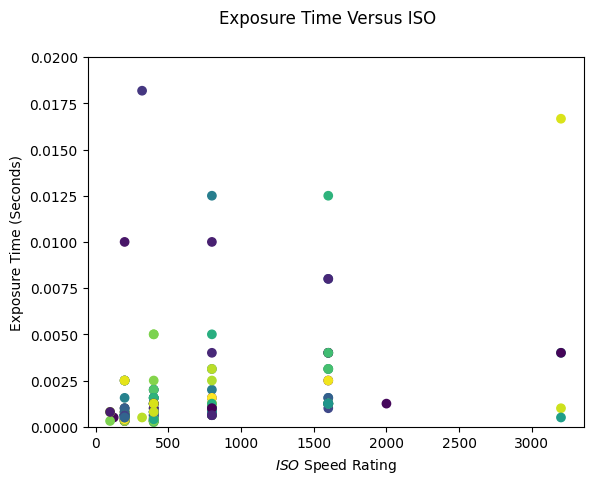How You Take Photos
This is a python script that visualizes the settings that you have on your camera across a set of photos you take
/Users/sammyrobens-paradise/Desktop/lights
Include All the Dependencies
First you will need:
- Python 3
- Homebrew
- pip (You can also use Conda but)
- Juypter Notebook
lets include all the depdencies. Before you begin, make sure you have installed the depencies. You can do this by running Make install which will install the dependencies in requirements.text. You can also manually install the dependencies listed below.
Install Dependencies
# install dependencies
import numpy as np
import matplotlib.pyplot as plt
import matplotlib.colors as mcolors
from PIL import Image, ExifTags
from PIL.ExifTags import TAGS
import glob
import os
Input the file path to the folder containing the images you want to visualize
# path_to_image_dir = input("Enter the complete path to the image folder")
path_to_image_dir = "/Users/sammyrobens-paradise/Desktop/lights"
print("Loading images from " + path_to_image_dir + "...")
directory = os.fsencode(path_to_image_dir)
image_paths = glob.glob(path_to_image_dir + "/*")
num_images = len(image_paths)
print(str(num_images) + " images found in " + path_to_image_dir)
Loading images from /Users/sammyrobens-paradise/Desktop/lights...
168 images found in /Users/sammyrobens-paradise/Desktop/lights
# Define all our classes, types and helper functions
class Exif:
ResolutionUnit: int
ExifOffset: int
Make: str
Model: str
Software: str
DateTime: str
XResolution: float
YResolution: float
ExitVersion: bytes
ShutterSpeedValue: float
ApertureValue: float
DateTimeOriginal: str
DateTimeDigitized: str
ExposureBiasValue: float
MaxApertureValue: float
MeteringMode: int
ColorSpace: int
Flash: int
FocalLength: float
ExposureMode: int
WhiteBalance: int
SceneCaptureType: int
FocalPlaneXResolution: float
FocalPlaneYResolution: float
OffsetTime: str
SubsecTimeOriginal: str
SubsecTimeDigitized: str
FocalPlaneResolutionUnit: int
ExposureTime: float
FNumber: float
ExposureProgram: int
CustomRendered: int
ISOSpeedRatings: int
SensitivityType: int
RecommendedExposureIndex: int
LensSpecification: list[float, float, float, float]
LensModel: str
LensSerialNumber: str
def reject_outliers(data, m=2):
return data[abs(data - np.mean(data)) < m * np.std(data)]
def shutter_speed_to_seconds(shutterSpeed):
return np.array(2 ** (-1 * shutterSpeed))
def aperture_to_stops(aperture):
return np.array(np.round((np.power(2, aperture) ** 0.5), 1))
class ImageMetadata:
def __init__(self, filepath: str):
source = Image.open(filepath)
self.source = source
self.exif: Exif = {
ExifTags.TAGS[k]: v
for k, v in source._getexif().items()
if k in ExifTags.TAGS
}
def _get_focal_plane_x_resolution(self):
return self.exif["FocalPlaneXResolution"]
def _get_focal_plane_y_resolution(self):
return self.exif["FocalPlaneYResolution"]
def _get_shutter_speed_value(self):
return self.exif["ShutterSpeedValue"]
def _get_aperture_speed_value(self):
return self.exif["ApertureValue"]
def _get_f_number(self):
return self.exif["FNumber"]
def _get_ISO_speed_rating(self):
return self.exif["ISOSpeedRatings"]
def _get_exposure_time(self):
return self.exif["ExposureTime"]
Generate a data list
The list contains all of our images and their standard exif tagged metadata stored as an ImageMetadata object
data:list[ImageMetadata] = []
for path in image_paths:
curImage = ImageMetadata(path)
data.append(curImage)
Now lets get into plotting some data…
Shutter Speed
lets plot the shutter speed of your photos
shutterSpeed = []
for item in data:
shutterSpeed.append(item._get_shutter_speed_value())
# print(shutterSpeed[len(shutterSpeed) - 1])
shutterSpeed = np.array(shutterSpeed, dtype=float)
Tv = shutter_speed_to_seconds(shutterSpeed)
Tv = reject_outliers(Tv)
bins = int(np.rint(len(Tv) / 2))
fig, axs = plt.subplots(1, 2, tight_layout=True)
fig.suptitle("Shutter Speed")
N, bins, patches = axs[0].hist(Tv, bins=bins)
fracs = N / N.max()
norm = mcolors.Normalize(fracs.min(), fracs.max())
for thisfrac, thispatch in zip(fracs, patches):
color = plt.cm.viridis(norm(thisfrac))
thispatch.set_facecolor(color)
axs[0].set_title("Histogram of Shutter Speed")
axs[0].set_ylabel("Photos")
axs[0].set_xlabel("$t$ Seconds")
axs[1].boxplot(
Tv,
patch_artist=True,
showmeans=True,
showfliers=False,
medianprops={"color": "white", "linewidth": 0.5},
boxprops={"facecolor": "C0", "edgecolor": "white", "linewidth": 0.5},
whiskerprops={"color": "C0", "linewidth": 1.5},
capprops={"color": "C0", "linewidth": 1.5},
)
axs[1].set_title("Box Plot of Shutter Speed")
axs[1].set_ylabel("$t$ seconds")
axs[1].set_xlabel(" ")
plt.show()
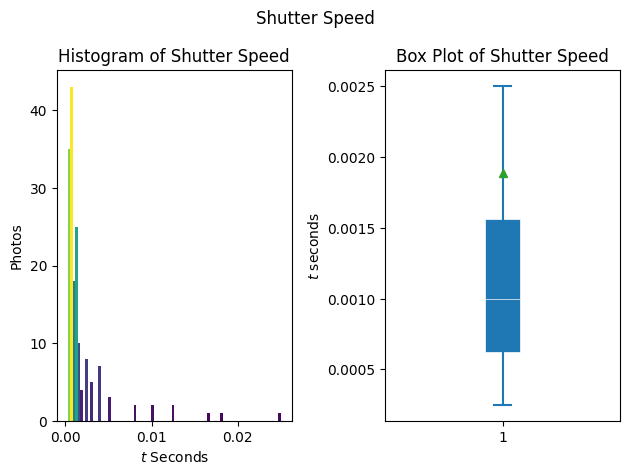
What about shutter speed relative to Aperture?
points = np.array(
[
[item._get_shutter_speed_value(), item._get_aperture_speed_value()]
for item in data
],
dtype=float,
)
points[:, 0] = shutter_speed_to_seconds(points[:, 0])
points[:, 1] = aperture_to_stops(points[:, 1])
Tv = points[:, 0]
Av = points[:, 1]
assert len(Tv) == len(Av)
plt.figure()
plt.suptitle("Aperture Versus Shutter Speed")
plt.scatter(Av, Tv, c=np.random.rand(len(points)))
plt.ylim(0, 0.026)
plt.xlabel("Aperture $f$ Number")
plt.ylabel("Shutter Speed $t$ Seconds")
plt.show()
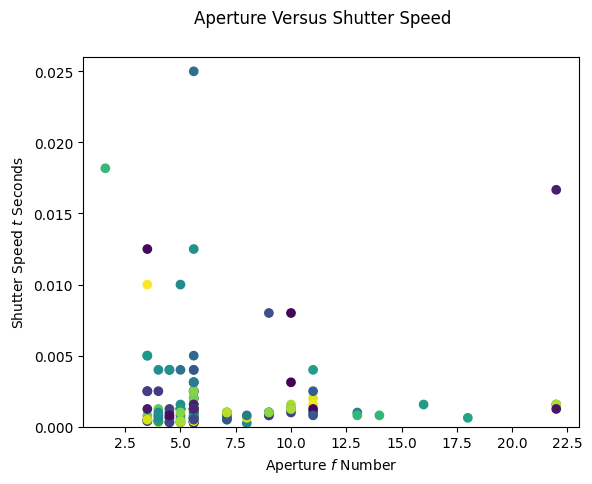
Whats the $f$ Number for your photos?
Fn = np.array([item._get_f_number() for item in data], dtype=float)
Fn = reject_outliers(Fn)
bins = len(np.unique(Fn))
fig, axs = plt.subplots(1, 2, tight_layout=True)
fig.suptitle("$f$ Number (F-Stop) is $\\frac{1}{f}$")
N, bins, patches = axs[0].hist(Fn, bins=bins)
fracs = N / N.max()
norm = mcolors.Normalize(fracs.min(), fracs.max())
for thisfrac, thispatch in zip(fracs, patches):
color = plt.cm.viridis(norm(thisfrac))
thispatch.set_facecolor(color)
axs[0].set_title("Histogram of $f$ Number")
axs[0].set_ylabel("Photos")
axs[0].set_xlabel("$f$ Number")
axs[1].boxplot(
Fn,
patch_artist=True,
showmeans=True,
showfliers=False,
medianprops={"color": "white", "linewidth": 0.5},
boxprops={"facecolor": "C0", "edgecolor": "white", "linewidth": 0.5},
whiskerprops={"color": "C0", "linewidth": 1.5},
capprops={"color": "C0", "linewidth": 1.5},
)
axs[1].set_title("Box Plot of Shutter Speed")
axs[1].set_ylabel("$f$ Number")
axs[1].set_xlabel(" ")
plt.show()
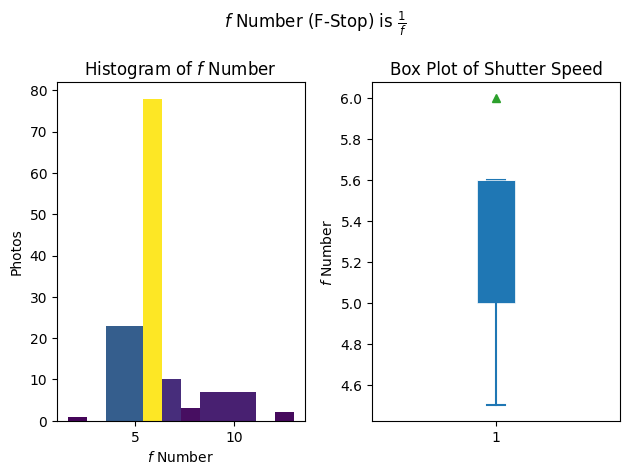
What about ISO?
ISO = np.array([item._get_ISO_speed_rating() for item in data], dtype=float)
ISO = reject_outliers(ISO)
bins = len(np.unique(ISO))
plt.figure()
N, bins, patches = plt.hist(ISO, bins=bins)
fracs = N / N.max()
norm = mcolors.Normalize(fracs.min(), fracs.max())
for thisfrac, thispatch in zip(fracs, patches):
color = plt.cm.viridis(norm(thisfrac))
thispatch.set_facecolor(color)
plt.title("Histogram of $ISO$ Speed Rating")
plt.ylabel("Photos")
plt.xlabel("$ISO$ Speed Rating")
plt.xticks(np.unique(ISO))
plt.show()
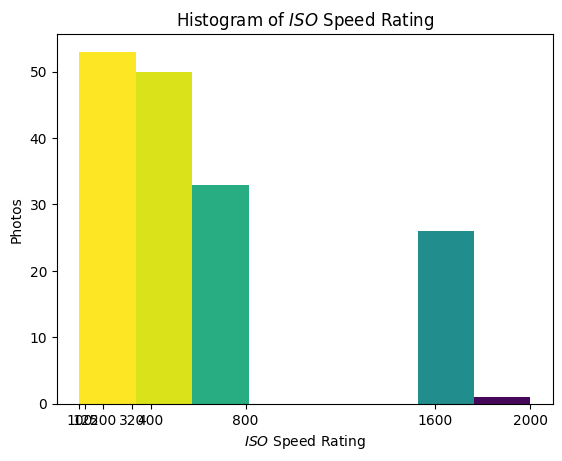
What about ISO versus shutter speed?
points = np.array(
[[item._get_shutter_speed_value(), item._get_ISO_speed_rating()] for item in data],
dtype=float,
)
points[:, 0] = shutter_speed_to_seconds(points[:, 0])
Tv = points[:, 0]
ISO = points[:, 1]
assert len(Tv) == len(ISO)
plt.figure()
plt.suptitle("Aperture Versus ISO")
plt.scatter(ISO, Tv, c=np.random.rand(len(points)))
plt.ylim(0, 0.02)
plt.xlabel("$ISO$ Speed Rating")
plt.ylabel("Shutter Speed $t$ Seconds")
plt.show()
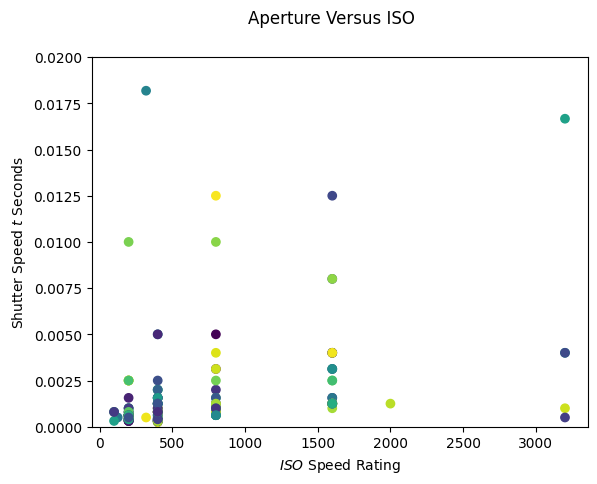
points = np.array(
[[item._get_ISO_speed_rating(), item._get_exposure_time()] for item in data],
dtype=float,
)
ISO = points[:, 0]
Et = points[:, 1]
assert len(Et) == len(ISO)
plt.figure()
plt.suptitle("Exposure Time Versus ISO")
plt.scatter(ISO, Et, c=np.random.rand(len(points)))
plt.ylim(0, 0.02)
plt.xlabel("$ISO$ Speed Rating")
plt.ylabel("Exposure Time (Seconds)")
plt.show()
